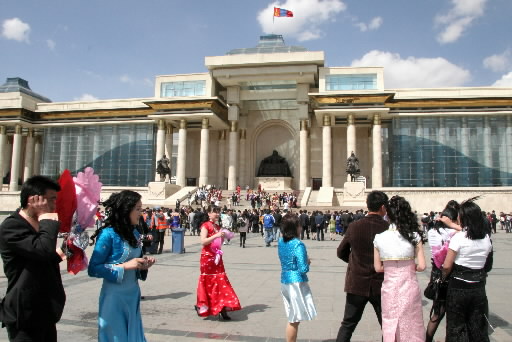Nuclear weapons can be eliminated: Chapter 3, Part 5
Jun. 23, 2009
Chapter 3: Mongolia's challenge
Part 5: A secure future
by Keisuke Yoshihara, Staff Writer
Providing small nations with support for their security
On the square in front of the government building where the president carries out his duties, college students in gorgeous dresses were taking commemorative photos after their graduation ceremony. It was a sunny spring day in early May and a bronze statue of Chinggis Khaan (Genghis Khan), standing dignified atop the front steps to the building, was watching over the young people who represent the nation’s future.
In late April, an international conference on nuclear-weapon-free zones was held at the Ministry of Foreign Affairs and Trade building, located on a corner of the square. The Mongolian government, which sponsored the conference, referred to the international contributions it can make based on its experience of the field.
One form of support involves providing assistance to other nations which seek to attain the “single state nuclear-weapon-free status.” Toward this end, the Mongolian government offers its accumulated know-how to small countries that are unable to join conventional nuclear-weapon-free zones comprised of multiple nations.
For example, Nepal is such a country, geographically lodged between China and India, both nuclear weapons states. Nepal and Mongolia share the same geographical challenge in that both nations have no shared borders with any non-nuclear weapons states.
Jargalsaikhany Enkhsaikhan, ambassador to Austria and the architect of Mongolia’s denuclearization policy, pointed out that “The number of nuclear-weapon-free zones is increasing in the world. In these circumstances, the international community should not neglect the smaller nations. As a sovereign state, every nation has the right to preserve its security.”
Mr. Enkhsaikhan cited Afghanistan, the nation caught between Iran, suspected of developing nuclear weapons, and Pakistan, at the center of the “black market” of nuclear materials. He said, “Afghanistan could be used as a route for smuggling nuclear weapons and radioactive materials. That nation must win assurance that no nuclear weapons or nuclear components will be brought into its territory.”
Mr. Enkhsaikhan also stressed Mongolia’s willingness to contribute to creating nuclear-weapon-free zones in Northeast Asia as well as in the Middle East. Indeed, Mongolia was credited with proposing the formation of the Northeast Asia Security Mechanism, involving Mongolia, Russia, China, South Korea, North Korea, and Japan, at the United Nations General Assembly in 2000.
Mongolia continues to strive for the future of the nation
After securing its “single state nuclear-weapon-free status,” the nation now envisions concluding a trilateral treaty with Russia and China to make the status legally binding. The Chugoku Shimbun sought the perspective of Sukhbaatar Batbold, 45, minister of Foreign Affairs and Trade, and received the following response in writing: “We must discuss the draft of the treaty further. It is too early to say when the treaty will be concluded.”
The draft reportedly needs additional adjustments, such as stipulating conditions to prohibit the dumping of radioactive materials near Mongolia’s border.
Mongolia, a small nation caught between bigger powers, has been courageously pursuing its “national security based on denuclearization.” Former President Punsalmaagiin Ochirbat emphasized: “Nuclear weapons were created by human beings and can be eliminated by human beings. The people of Japan are more aware of the danger of these weapons than any other people in the world. If Mongolia and Japan work together in this effort, we can help achieve this end.”
(Originally published on June 6, 2009)
To comment on this article, please click the link below. Comments will be moderated and posted in a timely fashion. Comments may also appear in the Chugoku Shimbun newspaper.








